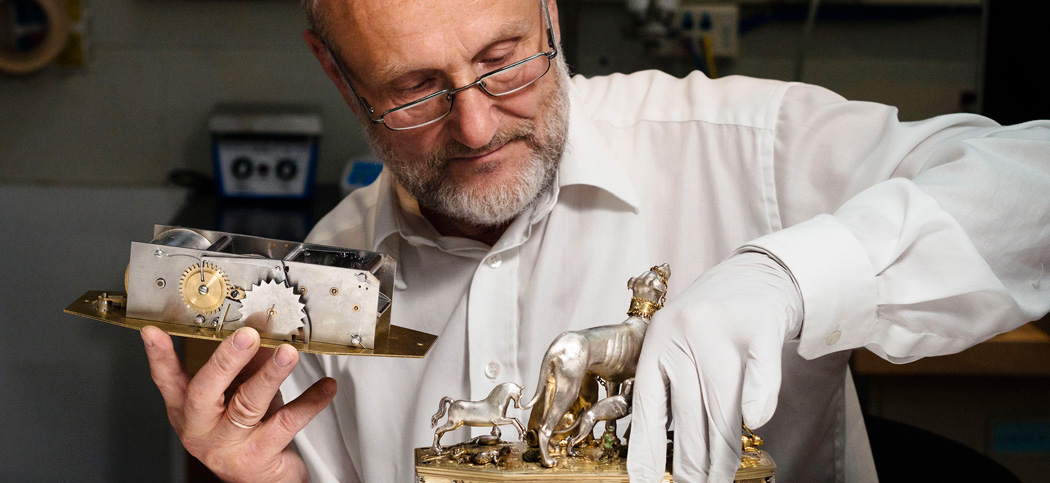Advertisement
A 17th-Century Mechanical Drinking Game, Revived
Resume
We here at WBUR wouldn’t know this from personal experience, but according to our research, modern drinking games usually involve a quarter, a deck of cards or a ping pong ball.
Back in the 17th century, though, European aristocrats took their partying to another level. We know this because an antique drinking game just went on display in the Museum of Fine Arts’ new Kunstkammer Gallery. It’s a mechanized wine vessel that’s been brought back to life after 200 years.

In German, Kunstkammer means “art room,” and the MFA’s new gallery houses 123 intricately crafted oddities. Its layout is inspired by the “cabinets of curiosities” that were trendy among the well-heeled in the 16th and 17th centuries. Conservator Susanne Gänsicke has been trying to revive a particularly bizarre piece for a decade.
In the MFA’s Objects Conservation Laboratory, Gänsicke introduced me to Rolf Lang, a master watchmaker and conservator from Dresden, and his assistant Marcus Werner. They snapped on special gloves so they could handle a silver object called an automaton.
“It’s an animated machine,” Gänsicke explained, “which is something like a robot.”
The mechanical object was created in about 1610-1620 by Joachim Fries, a famous German goldsmith.
“It’s called a 'Trinkspiel,' ” Gänsicke said, smiling. Then she translated: “It’s a drinking game.”

Gänsicke says exotic, wind-up sculptures were all the rage in the 1600s and 1700s. Aristocrats pulled them out to impress their friends at dinner parties.
This one depicts Diana, goddess of the hunt, astride a stag with magnificent, pointy antlers. She’s holding two hunting dogs on a leash. During a banquet, the host would remove the stag’s head to fill the cavity with wine. Then he or she would crank the device’s key and send it buzzing erratically around the table. If the automaton stopped in front of you, it would be your duty to drain the ornate, heavy vessel.
“I cannot envision how people would’ve been able to lift this whole thing — and drink from it — without spilling wine over your fabulous dinner clothes,” Gänsicke mused. “But maybe they had a lot of practice?”
Lang laughed at the question, because he knows they did. He’s heavily researched the piece’s history and lifestyles of the people who used it.

This drinking game has a fascinating, sad and complicated backstory. A powerful German family purchased it around 1600 and used it for parties at their castle. In 1945, that castle was bombed at the end of WWII, and the contraption was lost.
Then, in the mid-1980s, it was found in East Germany. Gänsicke says someone must’ve buried the piece for safe keeping. The silver exterior survived. But then the conservator showed me the original mechanism, which is made of more humble metals, like iron and copper alloys. It’s heavily corroded, almost mineralized.
“So it’s defunct,” Gänsicke said. “It’s a lump of rust.”

After Germany reunified the piece was returned to the family’s heirs. They eventually sold it through the art market, and the MFA purchased the beautiful but broken work in 2004.
About 10 years ago, Gänsicke discovered Lang had treated Diana in Germany after the automaton was recovered. So she asked him to replicate its innards. He said yes.
In German, Lang explained that it was important for him to use the same tools and methods that its creator used 400 years ago. He painstakingly rebuilt the mechanical parts in Germany, and flew to Boston to install it inside the sculpture. Then came the test run.
To everyone's relief, it worked.
“It could be hundreds of years that it hadn’t moved,” Gänsicke said before Lang demonstrated the object's renewed abilities for WBUR.
After a few adjustments, Lang turned the key to wind the device. It whirred to life. (You can watch it in action in the video below.)
Gänsicke and Lang observed the test, smiling like proud parents. Then, Lang joked and Gänsicke translated.
“Ah! He said we were corresponding for 10 years like a couple in love, and finally, Diana brought us together,” Gänsicke translated with a laugh. “We’re also from different parts of Germany. Rolf Lang is from East Germany and I’m from West Germany — and now there is just one Germany — but the meeting of professionals from different parts of the country is really a meaningful connection … and a rare one.”
!["[F]inally, Diana brought us together,” Gänsicke said of Lang. (Courtesy MFA)](https://media.wbur.org/wp/2014/06/1b-crop.jpg)
Today, she and Lang are thrilled to expose modern audiences to this quirky old drinking device.
“I don’t know if there’s anybody else in the world who really could’ve done the work that Rolf did,” Gänsicke said. “And its function is preserved for the future now. I mean, it’s resurrected.”
But if you visit the MFA, leave your wine at home. This strange drinking game will not be filled up any time soon.

